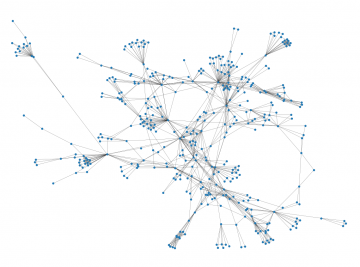
Achievement
This work presents a comprehensive and in-depth study of the collaborative dynamics of the field of peridynamics from its inception by constructing and analyzing networks that represent the scientists and their collaborations in the field. The study employs network analysis techniques (including advanced current flow centrality metrics) and persistent homology to: (1) characterize the global evolution of the peridynamics co-authorship network, (2) rank scientists in the field based on their collaborative profiles, and (3) provide suggestions for future collaborations between scientists in the field based on link recommendations.
Significance and Impact
To the best of the authors’ knowledge, this work represents the first analysis of the collaborative dynamics of peridynamics, an emergent field in continuum mechanics. Peridynamics originated from a paper published in 2000 and has since grown to encompass hundreds of researchers around the world. While there have been previous works studying the evolution of collaboration networks, fewer works studied the complete development of a new research field. Because the field of peridynamics is relatively young, tracing its growth can yield great insight into how the collaborative dynamics behind new research fields develop.
This work provides a thorough investigation of the complex underlying collaborative dynamics in peridynamics (not only at the global community level, but also at the local level of individual scientists and groups of scientists) and presents strategies to identify potentially productive future collaborations. The analysis presented in this work could provide means for the comparison of the collaborative dynamics between different fields.
Research Details
In this work, we studied the evolution of the peridynamics community by analyzing the corresponding co-authorship network at multiple time frames and scales. We presented our work in the context of social network analysis and network science, allowing us to compare the results obtained for the peridynamics co-authorship network with other similar networks. We found that the peridynamics co-authorship network has been growing exponentially over the last two decades in terms of number of scientists and publications. Additionally, our study shows that the peridynamics co-authorship network has a clear “core” of scientists to which Stewart Silling—the creator of peridynamics—belongs; this core was 25 times larger than any other connected group of scientists in peridynamics in 2019. Nevertheless, in the last decade, the majority or near-majority of scientists starting publishing in peridynamics either joined other groups rather than the “core” or formed new groups. This suggests a clear trend of expansion of the network, which is confirmed by the increasing average distance and diameter of the “core” over time. Yet our study also shows that the peridynamics co-authorship network is fairly clustered, and peridynamics scientists tend to collaborate on average with scientists not too distant apart in the network. Moreover, our analysis indicates that the peridynamics co-authorship network is scale-free.
We also analyzed the peridynamics co-authorship network at a local level, ranking the nodes of the ``core" based on different centrality metrics. No single ranking is authoritative, though a composite ranking can be constructed in an attempt to determine the most collaborative scientists in peridynamics according to selected metrics. We employed two classes of centrality metrics: degree centrality and current flow centrality. The former only considers nodal properties (number of co-authors and number of co-authored publications), whereas the latter utilizes the structure of the network by accounting for all the paths that either start or end at a node or pass through a node. We observed that many of the same names appeared as top ranked scientists for the different metrics, although the order varied depending on the metric used. We employed a composite centrality metric to obtain an overall ranking for scientists for the different years, and we identified the ranking changes of those scientists between consecutive years. We further extended this analysis to higher-order networks to identify the most collaborative groups (pairs and trios) of scientists in peridynamics.
Finally, we introduced a methodology for link recommendations based on two approaches. The first approach provides personal link recommendations, where a node is recommended links to increase its current flow centrality values. The second approach gives global link recommendations, where links are recommended to fill the holes present in the network. We demonstrated the first approach by providing personal link recommendations for top ranked composite centrality scientists. Then, we reported global link recommendations by identifying all the holes present in the peridynamics co-authorship network through persistent homology.
Combining the evolutionary analysis of the peridynamics co-authorship network, the local-level rankings, and the link recommendations, our work covered, in a sense, the past, present, and future of the peridynamics community (whether it be the projected future or a potential future).
Overview
Peridynamics is a relatively new field in continuum mechanics that has developed over the past 20 years. This work studies the evolution of collaborations in the field of peridynamics since its inception. For this purpose, we construct a network describing co-authorship between scientists in peridynamics. Each node in this network represents a scientist, and each link connects two co-authoring scientists with a link weight representing the frequency and strength of their collaboration; the entire network can be thought of as a graph representation of the peridynamics community. By constructing a network for each year, we are able to analyze the evolution of the network in time and discuss the implications of this evolution for the peridynamics community. Our study demonstrates that the peridynamics community has been growing exponentially in size in recent years. Centrality metrics are also used to identify the most collaborative scientists in the community. We compute link recommendations based on both elevating a scientist's position in the network with respect to certain centrality metrics or closing structural holes in the network identified with persistent homology. We further extend the analysis to higher-order networks whose nodes are groups of scientists in the community and whose links connect collaborating groups. In some sense, our work studies the past, present, and future of the peridynamics community.
To view the publication click here.
Last Updated: July 13, 2022 - 9:35 am